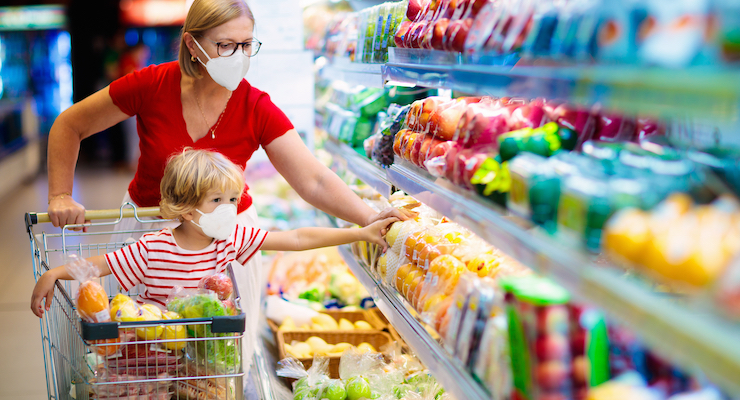Market Updates
IFIC Breaks Down Key Trends in 2021 Food & Health Survey
As pandemic food habits begin to wane, a number of positive approaches to diet and health are growing, IFIC said.

By: Mike Montemarano

More than one year into the COVID-19 pandemic, it appears that many consumers are settling back into shopping and eating habits which resemble patterns seen in the pre-pandemic times, while also engaging in some new food and health habits, giving researchers a preliminary idea of what the post-pandemic consumer marketplace will look like. One such effort to predict some trends in the upcoming year is the International Food Information Council (IFIC)’s 2021 Food & Health Survey, the results of which emphasize that consumers are becoming more mindful of social inequalities and disparities within our current food system, and that people want to engage more deeply with sustainable practices as they relate to the food industry.
“After more than a year of tremendous upheaval caused by a historic pandemic, Americans are craving stability and a return to normalcy when it comes to their food decisions,” Joseph Clayton, CEO of IFIC, said. “The 2021 Food & Health Survey reflects those desires, but it also provides evidence of trends from during and before the pandemic that are proving to be more durable. This year’s survey also offers interesting new insights into consumers’ feelings about their communities, as well as their obligations to the environment.”
Return to Normal
Since last year’s IFIC Food & Health Survey, the organization has extensively tracked the dramatic changes in consumer behavior that have gone on as a result of COVID-19. This year’s survey shows that many of these changes have begun to subside. For instance, 85% of Americans a year ago reported having experienced some change to their eating or food preparation habits because of the pandemic. In the 2021 Food & Health Survey, however, that number fell to 72%.
Pandemic-related behavioral changes that were adopted by consumers, by and large, may have dropped by as much as half since the crisis began. A year ago, 60% of consumers said they were cooking at home more than usual; this year, that number fell to 47%. Other major year-long declines included trends such as: snacking more (32%-18%); washing fresh produce more (30%-22%), thinking about food more (27%-13%), eating more in general (20%-11%); and eating more pre-made meals from the pantry or freezer (19%-11%).
Some changes appear to be more lasting, and have even accelerated in 2021, IFIC said. In 2019, 27% of Americans said they shopped for food online at least once a month. That number increased to 33% in 2020, but, a year later, that number climbed to 42% in early 2021. While there was a decrease in adults who shopped for food online at least weekly from 2019 to 2020 (13%-11%), that number jumped to 20% this year, with younger consumers, parents, and African Americans shopping online for groceries more frequently than the general population.
Food Insecurity Attributed to COVID-19
With changes in behavior come changes in attitude, IFIC said, and there are certain markers of food insecurity present in the 2021 survey results. 15% of Americans said that they often purchased less-healthy food options than they would have otherwise because they didn’t have enough money for healthier options. A similar number (14%) said they often worried about whether their food would run out before they had enough money to buy more, and the same amount of consumers delayed purchasing food because of other expenses like rent or utility bills. 13% of consumers purchased less food overall. Three-quarters of consumers who experienced these markers of food insecurity said that the pandemic at least somewhat played a role in those decisions.
While the results of food-insecurity questions were similar in 2018, cross-referencing the food-insecure groups of that year with 2021 revealed that African American respondents are more adversely impacted by food insecurity issues than three years ago, with certain food-insecure behaviors sometimes almost doubling.
22% of African American respondents said they often purchased less food overall because of money concerns (vs. 12% in 2018), 20% often worried their food would run out (vs. 12% in 2018) and 21% often delayed purchasing food due to other expenses (vs. 10% in 2018). 25% of African Americans in 2021 said they often purchased less-healthy options due to financial concerns, an increase from 19% in 2018.
Attitudes about Health
IFIC said that survey results indicated consumers are generally exhibiting positive attitudes surrounding health, with 73% of respondents reporting that they were confident in their ability to choose healthy foods.
Among a selection of definitions for “healthy” foods, consumers were once preoccupied in 2016 with what foods tend to lack (such as fats, sugars, etc.), rather than what healthy components a food may have. This year, 27% now say healthy food is defined by the presence of components such as fruits, vegetables, and nutrients (up from 17% n 2016), while 25% defined it by the absence of “bad” components (down from 35% in 2016). Another 25% simply defined healthy food as being “good for you” (up from 18% in 2016).
Approaches toward dieting, IFIC said, are also moving in a positive direction. In 2021, 39% of Americans said they were following a specific eating pattern or diet, but the reasons were less cosmetic than in previous years. Losing weight remains a top reason for following a diet at 38%, down from 47% in 2020. Along the same lines, just 29% said they were dieting to improve their physical appearance, down sharply from 39% in 2020.
Additionally, more consumers are aware of the Dietary Guidelines for Americans, with the number of adults who know at least a fair amount about the DGA rising from 23% in 2010 to 41% in 2020. In 2021, that number rose to 46%, likely attributable to the release of the most recent 2020-2025 edition of the DGA.
Social, Environmental Sustainability
While the pandemic recedes as an influence over consumer food choices, an emphasis on social and ecological sustainability in food choice which peaked over the past year is likely here to stay.
42% of consumers said they believe their individual choices about food and beverage purchases have a moderate or significant impact on the environment, and 53% said that if it were easier to understand the actual environmental impact of their choices, this issue would have a greater influence on their food decisions.
24% of respondents said meat and poultry have the biggest negative impact out of food sources and products on the environment, followed by bottled beverages (14%) and fresh fruits/vegetables (8%). Tied at 7% were seafood, frozen foods, dairy, and candy, chocolate, and other sweets. 24% of adults also report eating more protein from plant sources over the previous year.
For the first time this year, IFIC asked consumers questions about social sustainability. 59% of respondents say it is at least somewhat important that the food products they buy and consume are produced in ways that are committed to the fair and equitable treatment of workers involved. Parents with children under 18 years old are far more likely than those without non-adult children to view fair and equitable treatment as at least somewhat important (69% vs. 56%). Similar trends are seen between African Americans and non-Hispanic White consumers (68% vs. 56%) and between those who said they made community-supporting efforts on social/food issues in 2020 vs. those who did not (67% vs. 35%).
A Spirit of Generosity
With the significant amount of social, emotional, and economic upheaval experienced over 2020, IFIC included questions in this year’s survey about food issues in their communities, and found that 75% of respondents said they made an effort to help their community in the past year.
44% of adults cited that they supported local restaurants, while 42% said that they increased tips for restaurant servers and food delivery people. In addition, 25% bought food from local farmers, 21% shopped or dined at minority-owned restaurants and grocery stores, and 20% donated to or volunteered at a food charity or food bank. 18% of people also helped those in their community who needed assistance to get food or groceries.
Mike Montemarano has been the Associate Editor of Nutraceuticals World since February 2020. He can be reached at mmontemarano@rodmanmedia.com.


